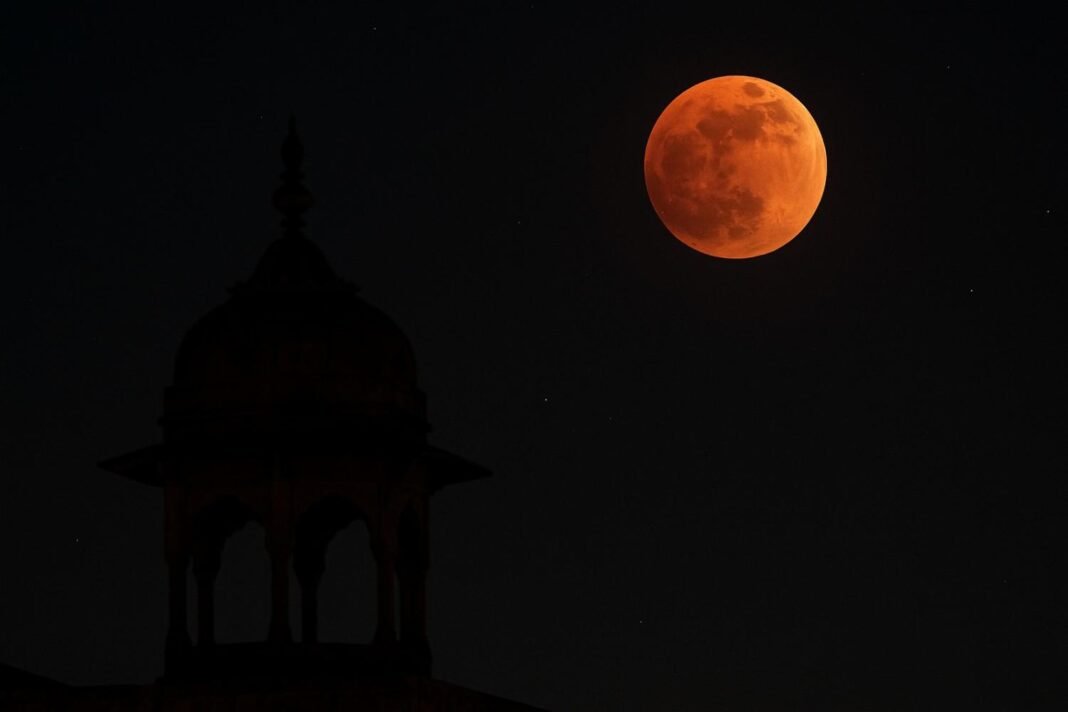A Night of Celestial Wonder
On the night of September 7–8, 2025, millions of skywatchers across India were treated to one of nature’s most extraordinary spectacles — a Blood Moon, or total lunar eclipse. Beginning shortly before 9 pm IST and lasting until the early hours of Monday morning, the cosmic event offered viewers a rare chance to see the Moon bathed in a glowing copper-red hue. The eclipse was also visible across much of Asia, Australia, the Middle East, and parts of Africa, but skipped the Americas entirely.
7 Sept 2025 • Blood Moon 🌕🔴 (Total Lunar Eclipse)#bloodmoon2025 #LunarEclipse pic.twitter.com/SRk5AvSCbN
— Utkarsh Singh (@Utkarsh__Singh) September 7, 2025
What is a Lunar Eclipse?
A lunar eclipse takes place when the Earth moves directly between the Sun and the Moon, casting its shadow on the lunar surface. Depending on how perfectly aligned the three bodies are, the eclipse can be partial or total. During a total eclipse, the Moon passes through the Earth’s umbra — the darkest part of its shadow — creating a dramatic dimming effect.
Unlike a solar eclipse, which requires protective glasses or projection methods for safe viewing, a lunar eclipse can be admired directly with the naked eye, making it accessible to everyone, from astronomy enthusiasts to casual stargazers.
Why Does the Moon Turn Red?
The Blood Moon’s striking colour is caused by a fascinating play of light. As the Earth blocks direct sunlight from reaching the Moon, the only light that filters through the planet’s atmosphere bends around its edges and illuminates the Moon. In this process, known as Rayleigh scattering, shorter blue wavelengths scatter away, while longer red and orange wavelengths penetrate through. The result: the Moon glows a deep copper or crimson, much like the horizon during sunrise or sunset.
Effectively, during a lunar eclipse, observers on Earth are witnessing a projection of “every sunrise and sunset on Earth” cast upon the lunar surface.
A Reflection of Earth’s Atmosphere
Beyond its beauty, the Blood Moon also holds scientific significance. The depth and shade of the Moon’s redness depend on Earth’s atmospheric conditions. A cleaner atmosphere allows more light to reach the Moon, making it appear brighter, while dust, volcanic ash, or pollutants in the air can make the Moon appear darker or a deeper red.
In fact, historians and scientists have examined medieval records of eclipses to track volcanic eruptions from centuries past. For example, a 2023 study by researchers at the University of Geneva linked unusually dark lunar eclipses between 1100 and 1300 AD to major volcanic events during the High Medieval period.
Thus, the Blood Moon is not only a celestial wonder but also a natural indicator of the Earth’s atmospheric health.
Timings Across India
According to astronomical records, the eclipse unfolded in stages across the country:
-
8:58 pm IST – Penumbral eclipse began
-
9:57 pm IST – Partial eclipse began
-
11:00 pm IST – Total eclipse began
-
11:41 pm IST – Maximum eclipse
-
12:22 am IST – Total eclipse ended
-
1:26 am IST – Partial eclipse ended
-
2:25 am IST – Penumbral eclipse ended
For nearly 48 minutes, the Moon was completely covered by Earth’s shadow, glowing red at its peak around 11:41 pm. Clear skies in many regions made the viewing experience even more breathtaking.
Why the Blood Moon Matters
The September 2025 eclipse was more than a dazzling show. It reminded observers of the deep connection between Earth’s atmosphere and the universe beyond. From a scientific standpoint, studying eclipses can provide vital data on climate, air quality, and long-term environmental changes.
Culturally, the Blood Moon has carried myths and superstitions for centuries, often regarded as an omen of change or transformation. Today, however, it is largely celebrated as a symbol of wonder and discovery, uniting people under the same night sky.
For India and much of the Eastern Hemisphere, this eclipse was a reminder that the cosmos is not a distant abstraction, but a living spectacle woven into everyday phenomena like the colour of the sky, sunrises, and sunsets.








